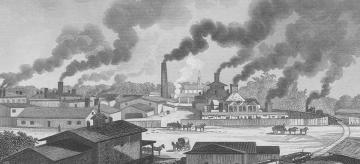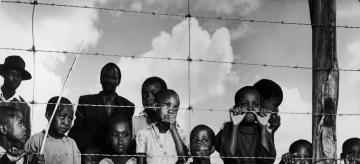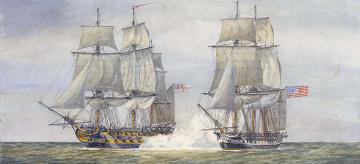How Did the Cold War Stay Cold?
Learn how the world’s superpowers, the United States and the Soviet Union (USSR), avoided nuclear war.
During the Cold War, the United States and the Soviet Union amassed tens of thousands of nuclear weapons—enough firepower to annihilate each other many times over.
Despite sky-high tensions, the fierce rivalry between the two superpowers never heated up into a direct war, which could have caused catastrophic destruction.
So how did the Cold War stay cold?
This video explores several factors that discouraged confrontation, including powerful alliance networks, prudent diplomacy, sensible arms control treaties, and—of course—the ever-looming knowledge that any attack could lead to the complete obliteration of both sides, if not all mankind.
Transcript: Why Did the Cold War Stay Cold?
What was the Cold War?
The Cold War was more than just spies, nukes, and submarines. At its core, it was fueled by the competing ideologies of the United States and the Soviet Union. The Soviet Union promoted communism, a system where government officials control the economy and many other parts of life in a country. In contrast, the United States generally promoted democracy and capitalism, systems in which individuals have more control over political and economic decisions.
This competition, which started right after World War II, is called the Cold War, because despite some close calls and conflicts, tensions between the U.S. and Soviet Union never heated up into a direct war.
So, why did the Cold War stay cold? There are several major reasons.
Cold War Treaties
One reason is that a balance of power existed between the two countries. Both sides had enormous militaries as well as their own alliance networks. The United States led the North Atlantic Treaty Organization, or NATO, while the Soviet Union led the Warsaw Pact. Members of each alliance pledged to defend other members if they were attacked. So the attacker wouldn't be fighting with just one country; they'd be fighting with the entire alliance, a prospect that discouraged, or deterred, countries from attacking any alliance member. Importantly, both the United States and Soviet Union established credibility by taking military action to support their foreign partners, demonstrating that they would be able and willing to follow through on their pledges to use force if an ally were attacked.
Nuclear Weapons and Mutually Assured Destruction
Another reason the Cold War stayed cold: the deterrence between the alliances was supercharged by a powerful new technology: nuclear weapons.
The United States developed the first nuclear bombs at the end of World War II, and within a few years, the Soviet Union produced its own. Both countries built enormous nuclear weapons arsenals, and each had more than enough bombs to annihilate the other. They also built special silos, planes, and submarines to ensure that if attacked with a nuclear weapon, they would still be able to fire their own back in retaliation.
Leaders on both sides recognized an idea known as mutually assured destruction. They knew an attack by either country would result in both countries being destroyed. This deterred either side from attacking the other. As the Cold War continued, tensions stayed limited in part because U.S. and Soviet leaders helped maintain both nuclear and conventional military balances through arms control treaties. Both countries agreed to limit how large and how powerful their arsenals could be so that one side wouldn't be able to attack with enough force to prevent the other side from striking back with devastating consequences.
U.S. and Soviet leaders also agreed to limits on what types of defenses they could develop, including missiles that could knock out an incoming nuclear missile before it reached its target. Limits on such defenses helped keep both sides vulnerable to attacks from the other, preserving the stability of mutually assured destruction. These treaties also increase transparency, giving each country a more accurate idea of their rivals' military capabilities, reducing the odds that some miscalculation could lead to war. And regular communication between officials in both countries helped avoid misunderstandings and overreactions.
U.S. and Soviet Foreign Policy
All these factors made it less likely that the U.S. and Soviet Union would go to war. But ultimately, it was the decisions by leaders of both countries to limit where and how they would take action abroad that kept the Cold War from heating up. The U.S. chose not to provide meaningful support to political uprisings in the eastern European countries that the Soviet Union controlled. Similarly, the Soviet Union never meaningfully interfered in the United States' domestic affairs, and the support it gave to its allies around the world was, with few exceptions, limited. This discretion helped the two countries largely avoid situations that could escalate into a direct war, a war that leaders knew could cause vast devastation.
Instead, the United States and Soviet Union competed against each other by intervening in countries that were less relevant to their core security, providing political, financial, and military support to friendly governments, sometimes even fighting directly in those countries' civil wars.
It was this type of war, often called a proxy conflict, that bogged down the United States in Vietnam, which in 1954 was divided into a communist North and a non-communist South. The U.S. supported the South's government, sending money, weapons, advisors, and eventually millions of American troops to fight against communist guerrillas in the South as well as the government in the North. Meanwhile the Soviet Union provided aid to those communist forces, which ultimately defeated the government in the South.
How did the Cold War end?
The U.S. effort [in Vietnam] was a costly failure. Over 58,000 American soldiers died, billions of dollars were spent, and the war caused widespread political turmoil at home. For its part, the Soviet Union in the 1980s paid a large price in the aftermath of its decision to prop up a friendly government in Afghanistan. The heavy political and economic costs of that war — costs increased dramatically by the U.S. decision to provide large-scale military and economic aid to Afghan groups opposing the government and the Soviet troops supporting it — put an enormous strain on the Soviet Union, which was already struggling to support a large military and a wide network of allied countries, all while depending on an economic model with serious structural flaws.
Eventually, it all started to fall apart.
In late 1989, thousands of Germans in the eastern communist portion of Berlin broke through the wall separating it from the free and democratic west Berlin. These images reflected and stimulated disillusionment throughout eastern Europe with the Soviet Union.
Within two years, the countries of eastern Europe had largely broken free of Soviet control, ending the Warsaw Pact, and the Soviet Union itself started breaking apart into separate countries. The Cold War was over, and the United States was left as the world's greatest power, as the post- Cold War era took shape.



